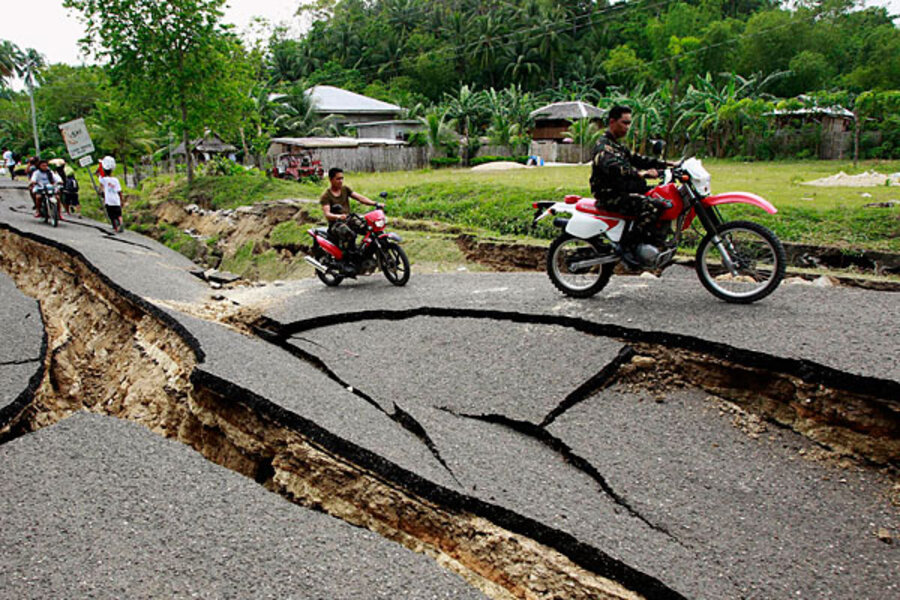Negros earthquake: Urgent rescue efforts as death toll rises
Loading...
| Manila
Dozens of people were still missing Tuesday following a strong earthquake that triggered landslides and damaged buildings and roads on a central Philippine island. The death toll reached 22, but officials said it was likely to rise further as rescuers struggle to reach remote areas.
Monday's magnitude-6.9 quake also collapsed bridges on Negros Island, forcing soldiers and firefighters to hike mountains to reach remote villages. Most of the confirmed deaths were in Planas village, a part of Guihulngan town where some 30 houses were buried under concrete debris.
Benito Ramos, head of the Office of Civil Defense, said by telephone that the number of dead from the earthquake had risen to 22. Most of the new deaths were injured victims who died in the hospital, he said.
RELATED: How well do you know Asia? Take our quiz.
But Adrian Sedillo, a disaster council officer in Negros Oriental province, said the death toll was likely to rise. There were reports of at least 14 more deaths, but the number will be added to the official count only after authorities verify that the bodies have been recovered, he said.
One of the dead not yet included in the count was a young woman whose body was dug out of a landslide in the mountain village of Solongon in La Libertad town. An unknown number of people were trapped there when a part of the mountain collapsed on about 100 houses.
Manila's ABS-CBN television showed footage of the woman's parents wailing at the landslide site after her body was retrieved late Tuesday by soldiers using shovels. The report said the woman had managed to send a text message to her relatives hours earlier telling them she was still alive and pleading for rescuers to hurry.
[ Video is no longer available. ]
Guihulngan Mayor Ernesto Reyes said crews were using backhoes to try to rescue people, but he added that at the rate deaths were being reported, the town may run out of coffins.
The damage may be worse than officials realized because the quake cut off communications to some villages, Reyes said.
"We have no water and power because electric posts were toppled," he told The Associated Press by phone. "Many of our roads were damaged, including bridges, and stores are closed. We're isolated."
President Benigno Aquino III will fly to Dumaguete city on Negros Island on Wednesday to inspect areas damaged from the quake and meet with victims of the temblor, his spokesman Edwin Lacierda said.
Aquino ordered air force helicopters and navy and coast guard vessels to come to the aid of rescuers, some of whom were digging with picks and shovels to look for survivors.
Workers were clearing and fixing roads and bridges leading up from the coast to mountains so heavy equipment, food and medicine could flow to the worst-hit villages.
The quake was caused by movement in an undersea fault 44 miles (72 kilometers) north of Dumaguete, the capital of Negros Oriental province, and about 400 miles (650 kilometers) southeast of the nation's capital, Manila. It hit at a depth of 29 miles (46 kilometers).
With at least 82 people still missing, many of them in landslides that buried homes, the casualties could top a 2004 quake on Mindoro Island, south of Manila. Seventy-eight people died there in 2004, about half of them in a quake-triggered tsunami. A local tsunami alert was issued following Monday's temblor but was soon canceled.
The Philippines is in the Pacific "Ring of Fire," where earthquakes and volcanic activity are common. The damage and casualties are compounded by shoddy construction in the impoverished nation. A magnitude-7.7 quake killed nearly 2,000 people in northern Luzon in 1990.
___
Associated Press writers Hrvoje Hranjski and Jim Gomez contributed to this report.





